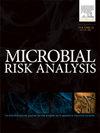An approach to risk categorization of Products of Animal Origin imported into the United Kingdom
IF 3
4区 环境科学与生态学
Q2 ENVIRONMENTAL SCIENCES
引用次数: 0
Abstract
There are thousands of potential hazards associated with imported foods and to achieve an excellent food safety record, resources need to be focused on higher-risk foods and preventive mechanisms.
We were tasked to develop an automated tool to assess public health risks from imported foods across multiple countries of origin, hazards and product types to replace manually conducted single product-hazard qualitative import assessments.
In this paper we describe the generic import assessment of risk to consumers from importing foodborne microbiological hazards into the UK, to identify those higher-risk foods. A risk categorization approach was developed as recommended by international standards laid out in the CODEX principles and guidance by FAO and WHO on food control. The approach combines an assessment of the inherent risk of the commodity (product characteristics), and any hazard mitigation or control measures undertaken in the producing country (control characteristics) and incorporates real-world global data relating to food safety incidents over a three-year time window (compliance) for that product.
With the broad diversity of foods imported, food stuffs are grouped into commodity groups using the codes in the international Harmonised System of classification. The mapping of trade into commodity groups and the scoring system developed to estimate risk are presented.
Results by exporting country were generated for 16 selected public health hazards identified from global food safety incident data using expert elicitation.
To ensure the approach is dynamic, can keep pace with global trends, and uses resources efficiently, the assessment has been automated and predominantly uses data that is global, publicly available and routinely updated.
The results support risk managers in their regular reassessment of the controls that should be placed on foodstuffs imported into the UK.
英国进口动物源性产品风险分类方法
我们的任务是开发一种自动化工具,用于评估进口食品在多个原产国、危害因素和产品类型方面的公共卫生风险,以取代人工进行的单一产品危害定性进口评估。本文介绍了英国进口食源性微生物危害对消费者风险的通用进口评估,以确定那些风险较高的食品。根据国际食品法典委员会(CODEX)制定的国际标准以及联合国粮农组织(FAO)和世界卫生组织(WHO)关于食品控制的指导原则,我们开发了一种风险分类方法。该方法结合了对商品固有风险的评估(产品特性)和生产国采取的任何危害缓解或控制措施(控制特性),并纳入了与该产品三年时间窗口(合规性)内发生的食品安全事件有关的全球真实数据。由于进口食品种类繁多,因此使用国际统一分类系统中的代码将食品分为不同的商品类别。为了确保该方法是动态的,能够跟上全球趋势,并有效利用资源,该评估已实现自动化,并主要使用全球、可公开获得和定期更新的数据。
本文章由计算机程序翻译,如有差异,请以英文原文为准。
求助全文
约1分钟内获得全文
求助全文
来源期刊

Microbial Risk Analysis
Medicine-Microbiology (medical)
CiteScore
5.70
自引率
7.10%
发文量
28
审稿时长
52 days
期刊介绍:
The journal Microbial Risk Analysis accepts articles dealing with the study of risk analysis applied to microbial hazards. Manuscripts should at least cover any of the components of risk assessment (risk characterization, exposure assessment, etc.), risk management and/or risk communication in any microbiology field (clinical, environmental, food, veterinary, etc.). This journal also accepts article dealing with predictive microbiology, quantitative microbial ecology, mathematical modeling, risk studies applied to microbial ecology, quantitative microbiology for epidemiological studies, statistical methods applied to microbiology, and laws and regulatory policies aimed at lessening the risk of microbial hazards. Work focusing on risk studies of viruses, parasites, microbial toxins, antimicrobial resistant organisms, genetically modified organisms (GMOs), and recombinant DNA products are also acceptable.
 求助内容:
求助内容: 应助结果提醒方式:
应助结果提醒方式:


